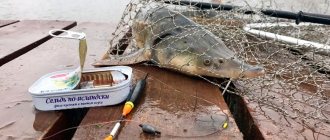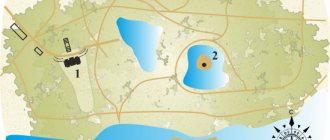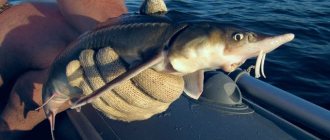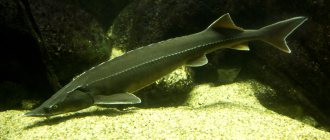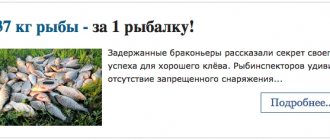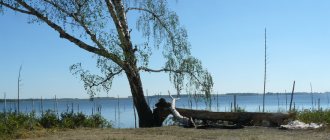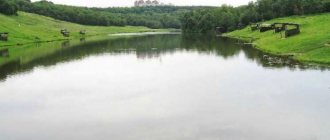Fishermen have been actively engaged in sterlet fishing for a long time. This fish is highly valued by consumers for its tasty meat, as well as its simple preparation process.
Another feature of the sterlet is the absence of such a disease as opisthorchiasis. In Russia, the capture of this inhabitant of the aquatic environment is allowed. You just need to buy a license that gives you the right to do this.
The price of a one-time license is 462 rubles, and a monthly license is 4620 rubles.
Recently, experts have noted an increase in the population of this fish. This fact is mainly associated with a decrease in pollution of water bodies in the eastern part of Russia: a refusal to float timber down the river, and a stop to the construction of hydroelectric power stations.
But even despite this, a large specimen is rarely caught, using several types of gear.
What to use to catch sterlet?
The best bait for catching sterlet is a worm. The size of the worm in this case does not matter. Most anglers puncture the earthworm well to prevent it from breaking off.
Using a donkey when catching sterlet
One of the main fishing methods is to use a donkey or a bait. Fishing using this method is carried out during the period of completion of spawning - late spring, mid-summer.
The most optimal and effective option is to use a donkey on which a rubber shock absorber is installed.
Immediately after spawning, the sterlet usually swims near the shore, trying to find food.
It is in this place that you need to throw the donk.
But in the middle of summer, the fish swim to longer distances from the shore and therefore it is necessary to use a more powerful spinning rod, for example, a carp spinning rod.
You also need to stock up on a heavy sinker to throw it over a long distance.
It is very important that the bottom gear is in the place of the word. In this case, the fisherman must take into account its possible drift by the river current.
The leash size is around 30 cm, and its thickness is 0.2 mm. The color of the fishing line does not matter.
This is due to the fact that sterlet is not very sensitive to pain and does not resist, unlike many other fish. Despite all the seemingly simplicity, the fisherman should not forget about the spikes that the fish has, otherwise they can cause some difficulties.
Methods of catching sterlet
Current methods of catching sterlet in open water. We do not consider seine tackle, because it is classified as poaching gear.
Rosrybolovstvo is considering lifting the ban on sterlet fishing in the Volga-Caspian basin and, accordingly, stopping the imposition of fines.
- In certain areas (reserves, fish farms, fish hatcheries).
- During spawning.
- Fishing with a net.
- Airplane fishing.
- On the move.
The fine for 1 caught sterlet is 4,572 rubles. Images are attached below.
Basic donka
When catching sterlet on bottom gear , be sure to consider the following details; If you are a beginner and do not know the features of a particular area, then you should not use two leashes when rigging. Hook only one, otherwise, if the bottom is covered in snags, you will get caught when fishing for fish, the leash will break, and the sterlet will come off, which is very bad. Usually the sterlet manifests itself very quickly; if there is a school at the casting point, then 15 minutes is enough for the fish to start biting. If much more time has passed, then hurry to change place.
Anglers who fish in a well-known area can safely attach two leashes , but it’s definitely not worth it anymore - sterlet is a bottom-dwelling fish, there’s no point. The size of leashes needed is from 15 to 25 cm long and 0.20-0.25 mm thick . Choose the highest quality fishing line for leashes to avoid breakage, and also, cheap fishing line is prone to twisting, which will interfere with normal fishing. The optimal fishing line length is 150-200 meters. The feeder also performed well for carp fishing.
Ryobi Ecusima with size 3000 is suitable for catching small sterlet weighing up to 1.5 kg
When choosing a reel, pay attention to its free movement - this will make it easier to fish for sterlet. The fish do not particularly resist, especially the females after spawning, which makes fishing in the summer easy and enjoyable, because the bite at this time is observed around the clock. The reel size should be 3000-4000 for medium-sized sterlet.
fishing rod that is convenient for you, the main thing is that it is durable. The length is enough up to 2.5 m if you fish from a boat. When fishing from the shore, it will be more convenient to fish with a 4-6 meter rod. The position after casting will be correct in case of strong currents if you position the feeder vertically; In still water, keep it parallel to the shore.
The sinker must be heavy, at least 100 g , and sink instantly and hold the tackle in the current.
During a flood, sterlet usually stands in quiet backwaters and likes to feed near the border of fast currents and quiet water. This applies to the summer period. With the arrival of autumn, the sterlet begins to hide in deep-sea holes, moving away from the shores, so it prepares for wintering.
As a rule, during the day the sterlet likes to swim along the fairway, so when casting, take into account that the load flies about 20 meters.
Video on making bottom gear (tackle):
Tackle elastic band
Catching sterlet with an elastic band is very convenient if you plan to fish in one place for more than one day, and also if the bottom is smooth and clean. This method is simpler than fishing with a donk, because you don’t have to constantly get the gear out. You are allowed to attach no more than 5 hooks to an elastic band, but this is quite enough; you can pull out several sterlets at once.
The first version of the donkey with an elastic band
Second option with 4 leashes
For a five-meter fishing line you need 1 meter of elastic - this is how we calculate the tension coefficient. Take leashes for elastic bands from fluorocarbon measuring 0.2-0.23 and 15-25 cm . The load will show itself better in a wide shape, for example, in the form of a spoon or any geometric figure; it should lie flat on the bottom and not be carried away by the current. Weighing no more than 200 grams . and 15 cm . in diameter.
A complete article on making your own elastic bands.
How to choose hooks
When fishing with a donk, use a hook with a long shank No. 6; such a hook is more convenient to remove from a long mouth and you can place a large bait on the tip. If you prefer to fish with an elastic band, stock up on enough hooks, they get dull very quickly on the rocky bottom; or better yet, take a special sharpener for sharpening the hook - this will protect you from unwanted fish falling off the hook.
Hooks must be of high quality (take trusted companies, don’t skimp), it’s good if they unbend when hooked. If you take cheap ones, you will end up not doing sterlet fishing, but endlessly replacing gear. Opt for hooks without a beard, then you will be able to painlessly release the sturgeon back into the river if it turns out to be small.
How to increase your fish catch?
Over 7 years of active fishing, I have found dozens of ways to improve the bite. Here are the most effective ones:
- Bite activator . This pheromone additive attracts fish most strongly in cold and warm water. Discussion of the bite activator “Dry Blooder”.
- Increased gear sensitivity. Read the appropriate manuals for your specific type of gear.
- Pheromone -based lures .
Bait for sterlet
Experienced fishermen know that sterlet is quite unpretentious in choosing bait. Fish prefer live bait. You can use a dung worm or an earthworm.
The fish also readily reacts to crustaceans, maggots and other larvae.
Various combinations of baits have also proven their effectiveness. For example, a bait consisting of three parts - an earthworm and two maggots. Some combinations are focused on achieving a strong odor.
You can use pieces of decomposing fish or garlic this way. The most suitable place for this bait is at the bottom of the reservoir. Sterlet, although not a predatory fish, still pecks at fry. One of the advantages of this bait is the possibility of catching both sterlet and pike.
Another type of bait is silicone, which usually replaces fish eggs. To more effectively imitate blende, it is necessary to use the caviar smell and the red color of the silicone itself. Monofilament fishing line is best suited for this type of bait so as not to spook the prey.
It is worth trying various soft products in the form of bait. Since the sterlet has a huge mouth opening, bulky objects are best suited. It is very important that they are as soft as possible, otherwise the fish will mistake the bait for a stone and will not swallow it.
Sterlet, sterlet fishing
We sat on the banks of the Oka, not far from the removable bridge, waiting for the “goat” promised at the sponsored collective farm. Below, near the water, two citizens settled down with the “donks”. By the way, such bottom fishermen are jokingly called “ground fishermen.” The first - leisurely, lean, wearing glasses and a crumpled felt hat - was an exact copy of Perov’s immortal “Rybolov”. The second was younger, thicker, broad in the shoulders and very mobile. The lovers apparently had a long-term friendship, although they called each other by name and patronymic and by “you”. The thin one was called Fyodor Konstantinovich, the fat one, more simply, Ivan Ivanovich.
The fish were biting unimportantly: the skinny guy had a small underbreed dangling on the kukan, his nose pressed into the sand, and the fat guy had an already whitened ruff floating belly up in a bucket with his gills spread out.
Fyodor Konstantinovich, apparently, was more experienced. That’s why, after a sharp bite on the fat man’s fishing rod, he silently shrugged off his friend with his shoulder and, taking the fishing line, confidently hooked and dragged the fish. Ivan Ivanovich unquestioningly handed over the reins of government to his authoritative friend.
But when a large grayish fish came into the woods near the shore, Ivan Ivanovich was seriously taken aback. Dancing some intricate steps around the lean man, he began heart-rendingly shouting the same phrase:
- Fyodor Konstantinich, - sterlet! Fyodor Konstantinich is a sterlet!
And only a minute later, when it was all over and the tip of the torn vein was dangling in the consultant’s hand, Ivan Ivanovich spat bitterly and said in a natural human voice:
“There’s nowhere to go from teachers!” Pop-eyed Chubuk! All of you, Fedka! Your advice! Bet and bet zero fifteen. So they set it... Wait for this one to bite again!..
Yes, of course, it’s not often now near Ryazan that you can catch a large sterlet... And how many of this wonderful fish used to be found in the Oka and Volga, in Unzha and Vetluga!..
“Sheksninsk is a golden sterlet,” the Russian poet Derzhavin once wrote.
I have not been to Sheksna and therefore could not admire the Sheksna sterlet. Yes, they say, there are also few sharp-nosed, mustachioed, bony-shelled fish left on Sheksna.
But on the Sura, which washes the oak groves of Chuvashia, a fast, friendly, but for some reason somewhat muddy river, the sterlet is still found.
And, of course, there would have been many times more of them, sterlets, if the terrible Sur buoy-keepers had not crippled the fish with barbaric “checker” tackle, if all sorts of swindlers, poachers, had not been straining out the fish at night with “smooth” nets, and we, amateur fishermen, had let them go undersized sterlets caught on the hook back into the water. So then the good glory of this primordial Russian fish would be restored.
Sursk sterlet is not golden, but gray in color; perhaps the belly is slightly yellowish, as if dirty. However, this does not affect her taste in any way.
Catching even a large sterlet on Sura - say, two kilograms - was not particularly tricky. There would be a boat and a couple of bottom fishing rods. But getting the “granny” - the bait loved by the sterlet - is a whole event.
And that’s what’s surprising! You open the stomach of a caught sterlet, and it is chock-full of bloodworms. Yes Yes! The very same bloodworm, which to “wash” with a ladle in any grassy bay is a complete trifle. But go catch a sterlet with bloodworms. He won't take it! He won't take it for a worm either. Be sure to give her “bubka”!
...Probably, nowhere will you find such grimy fishermen as on Sura. And all because the “granny” is mined underwater, in graphite clay. And even a tiny piece of this clay can so decorate the face of the “clay mover” that his closest friends do not immediately recognize him.
“Granny” - a mayfly larva - lives in underwater caves, which it excavates among dense clayey layers. Sometimes such caves are located at a depth of several meters from the surface of the water. So try to pick out the “grandmother” from there!
We bought an iron shovel at the general store, bent its edges inwards and got a cylinder with a wide slit in the middle. The blade of the shovel was sharpened by sharpening it with a file. Then we planted our projectile on a long spruce pole.
The projectile had to be lowered into the water and forcefully driven into the clay, then turned, rocked and pulled back out, and on the shore or in a boat the contents were picked out from the cylinder and the larvae were selected. This is where the real mess happened. There were times when we were lucky: in one go we came across ten, even fifteen larvae of “blueblood”, as “granny” is called here. But much more often there were fewer, and very often not a single one. It happened that a whole day of searching barely met the needs of one June morning.
And something else happened too. The “grandmother” was attacked by “uninvited guests” - a big-eyed, voracious silver bream, shamelessly freeing our hooks from the bait. obtained through such truly hard labor.
The best time for catching sterlet on Sura is from four to seven in the morning. During these hours, according to Sabaneev’s figurative definition, she “creeps” along the gristly pebble bottom in search of food. Here we caught it, anchoring the boat across the river, at the exit from a deep sandy hole.
The hole was six to seven meters deep, and at the riffle it was one and a half meters deep. Therefore, we fished somewhat unusually - from the depths to the shallows. The fishing rods used were the simplest - short rods, long lines. A leash with a hook was tied to a strong half-millimeter line, and a flat or pyramidal lead weight was attached to the outlet from the leash. The load was heavy, about a hundred grams. We equipped such bottom fishing rods with bells made from a copper gun casing. The rods were installed at a steep angle, conscientiously secured in the boat, since there were cases when the fish pulled them into the water.
At about eight o'clock we returned to the shore, had a quick breakfast, and from nine to eleven we again sat in the boats and caught sterlets, but not on the rift, but in the hole itself.
In the afternoon we did everything except fishing: picking berries, swimming, sunbathing, playing volleyball. Or again - let it be thrice wrong! - prepared "grandmother". We knew: don’t expect a good sterlet bite in the evening!
And we also established: before a thunderstorm and even during a thunderstorm with rain and wind, sterlet pecks especially greedily.
He takes the sterlet sharply - the tip of the rod twitches, the bell rings. And it almost always detects itself. The resistance of a sterlet on a hook is twice as weak as that of a pike of the same weight. Sometimes, like a pike, it makes a “candle” when dragging.
Usually sterlet travels in flocks of five to seven. In this case, the bites follow one after another. And then there is an “intermission”, often quite long.
The caught sterlet is released from the hook with great care, for fear of cutting your hand with the thorns. For this operation, it’s a good idea to have old gloves or wrap the fish with a rag.
narubalke.ru
Lure
Since sterlet has a well-developed sense of smell, it is necessary to use bait with a strong odor.
Experienced fishermen advise the following:
- groundbait from oatmeal feed;
- bait from roach and bark beetle;
- groundbait from cake + bark beetle larvae;
How to catch sterlet on the Ob?
The Ob River basin is one of the leaders among reservoirs in terms of the number of sterlet in them.
To make fishing on the Ob successful, you need to know the preferences and habits of the local fish.
Sterlet is a fairly secretive fish; it mainly presses to the bottom and likes to be in great depths.
However, as soon as dusk falls, it appears in shallow water, swimming in the coastal vegetation.
There, in the thickets, a sterlet is trying to find food for itself. Sometimes it even catches various insects, opening its mouth wide above the surface of the river surface.
This inhabitant of reservoirs loves to be in cold, clear waters, with fast currents and a sandy or gristly bottom.
Sterlet is quite rarely found alone and moves almost regularly, only choosing one place for wintering. In winter frosts, this fish is located in the deepest area of the river bottom, or even lies in holes. As a rule, sterlet waits out the cold in the lower reaches of reservoirs.
It is also worth noting that during high water, fish move in large schools, aiming to spawn. Due to the strong flooding of the river, sterlet has much more opportunities to get caught in the nets placed along the bottom.
During this period, fishing for sterlet is extremely difficult and not productive, and the fish can spawn without problems.
How to catch sterlet on the Irtysh?
Currently, sterlet fishing on the Irtysh River can only be done with a special license. Basically, the fish like to stick to the stream or stay in deep holes at the very bottom.
Very rarely and reluctantly, fish swim out into shallow water, and they only do this in the morning. The fish often feeds on crustaceans and various larvae.
In a body of water unknown to you, first you need to find a catchable place. As a rule, the best place is the exit from the pit. From this place it is possible to fish both the pit itself and the adjacent shallows.
Is it possible to catch sterlet with a fishing rod?
When fishing for sterlet with an ordinary fishing rod, you must use bottom equipment. This fact is due to the behavior of the sterlet, its predominant habitat at the bottom of the reservoir. In addition, bait must be attached to the fishing line, pre-equipped with a shock absorber.
This is necessary to significantly reduce wiring. This method is also very effective in sport fishing, when the fisherman is faced with the task of catching this fish quantitatively.
The most important problem when fishing with a rod is finding a place to fish, where the fish are looking for food. Of course, in this type of fishing it is necessary to choose the most attractive bait.
In conclusion, it is worth recalling once again that small sterlet must be released back into the reservoir. And not because if this is not done, then problems with the Fishery Supervision Authority may arise. Big problems may arise with sterlet, and therefore with us, just as they have already arisen on the Volga.
Source: fastcarp.ru
Disappeared delicacies from Oka and Klyazma
Among the numerous finds discovered by archaeologists in the cultural layers of Vladimir, Bogolyubov, Yaropolch-Zalessky, and now stored in the archaeological collections of the Vladimir-Suzdal Museum-Reserve, there are many that relate to fishing. Forged hooks, spears, ceramic and stone sinkers of nets, bone heads for weaving nets indicate an intensive and developed fishing industry in ancient times on the territory of the modern Vladimir region.
Bones and scales of fish are abundant material from the cultural layers of ancient settlements; from them it is possible to establish the types of fish hunted in those days. Very little written evidence of fishing has been preserved, and most of it refers to the most economically valuable fish species. Three species of fish known to us from historical documents - Russian sturgeon (also known from finds of osteological material), whitefish and Caspian salmon - can be considered forever extinct in the waters of the Vladimir region.
Russian sturgeon
Large fish can reach over 2 meters in length and 12-24 kilograms in weight, occasionally up to 80 kilograms. The antennae without fringes sit towards the end of the short snout. The lower lip is interrupted in the middle. There are 24-50 lateral bone bugs, 5-19 dorsal bugs, 6-14 abdominal bugs. An anadromous fish, but in the Volga there are residential forms that constantly live in fresh water. Going to the rivers in spring and autumn. Eggs are laid in sections of rivers with fast flows and dense rocky soil, often associated with outcrops of ancient glacial moraine-pebble deposits, at depths of 4-10 meters. Fertility is from 80-840 thousand eggs. Juveniles live in the river for up to 3 years and then move to sea areas. Life expectancy is up to 50 years.
The most ancient remains of sturgeon fish - bone bugs, fin rays, gill covers - date back to the 12th century. Judging by their finds in the cultural layers of the medieval cities of Vladimir, Yaropolch-Zalessky and the village of Bogolyubov (excavations by Nikolai Voronin), in ancient times Russian sturgeons were actively hunted. It is necessary to make a reservation that in the future similar finds may be found at other more ancient sites. In the 17th century, the Oka and its tributaries were rich in sturgeon fish, especially sterlet. Thus, from September 1, 1687 to August 31, 1688, 470 sterlets were delivered to the Moscow Feed Palace from the Oka River from the Murom Sevruga villages, and from the city of Kasimov - 5765 sterlets, 4 sturgeon, 1 sturgeon and, probably, 1 thorn (now in Krasnaya book of the Vladimir region), called “Kostlivets” in the document. The sturgeon sizes were as follows: one - 133 centimeters, two - 124 centimeters, two - 111 centimeters, one - 93 centimeters, three - 89 centimeters, one - 80 centimeters.
Sterlet: description and behavioral characteristics
Sterlet is part of the sturgeon family. But if you compare it with sturgeon, it is small in size.
External characteristics:
- The adult has a long nose with a sharp tip and short antennae that reach all the way to the mouth.
- The surface of the body is not covered with scales. There are brushes on the surface - bone growths. They are located in parallel rows along the entire body. There are 5 rows in total - 1 row is located along the entire back, 2 rows on the sides and 2 along the entire belly.
- Between the rows of scutes there are growths of bone plaques.
- Interestingly, on the surface of the wall the brushes close tightly, and thereby form sharp shields.
- The color of individuals can be different, this is influenced by environmental conditions. The most common individuals are those whose back is brown with a gray tint, and their abdomen is pale yellow. The fins are gray in color, and the shields on the sides are light shades.
- There are species with a blunt nose. These individuals are mainly distributed in lakes.
- The length of an adult fish is from 50 to 60 cm, and the weight is from 1.5 to 2 kg. Sometimes there are large species, the maximum length of the fish can reach 100-125 cm, and weight up to 16.
Features of behavior:
- Nutrition. Individuals eat mainly invertebrate inhabitants - worms, insects, larvae, crustaceans. Sometimes they can eat the eggs of other fish.
- Reproduction. Has very early puberty. The female can already breed at the age of 5 to 8 years, and the males at the age of 4 to 5 years.
- The spawning period begins in April and lasts until the first days of June. Each female lays from 15 to 20 thousand eggs. The temperature during spawning should be from 12 to 17 degrees.
- Peculiarities of behavior during feeding. Usually in the evening or at night it begins to rise to the top of the water and begins to hunt. Individuals roll over onto their backs and catch insects with their mouths. With the onset of dawn, it swims into deep places and lives there until dusk.
- Features of lifestyle. She leads a cautious, calm and secretive life. Therefore, it lives at great depths.
- During the winter season, it swims in deep places and hibernates.
Catching sterlet on the Ob River
On the Ob, sterlet is found quite often, at least more often than on the Oka. Therefore, catching chechug on the Ob River is quite popular. Most of all, she prefers the riverbed, especially during spawning. Sterlet, as a rule, rarely swims alone, but mostly travels in a flock.
In the summer on the Ob it moves only downstream, but in winter it hides in deep-sea holes. In winter, the salmon eats very little, so it is eaten off in the summer. It is very difficult to catch it during floods and floods, since it has much more room for maneuver.
Habitats and fishing calendar
This species is widespread in the rivers of the basins of such seas as the Black, Azov, Caspian, White, Barents and Kara. Distributed in large numbers in the Volga basin, mainly in the middle and lower reaches.
It also lives in Tvertsa and Lake Seliger, is present in the Oka to Orel, in the Moscow River, Kama, Vyatka and other rivers of the Volga basin. At the beginning of the 19th century, through canals it penetrated into the Northern Dvina basin, into the basins of Lakes Ladoga and Onega.
It is also acclimatized to the Western Dvina and Pechora. It is found in small quantities in the Kara, Ob, Irtysh and Yenisei. In the Dnieper basin: in the Smolensk region - the Dnieper River and the Bryansk region - the Desna River. In the Don River basin, it is found throughout its entire length from the Rostov to Tula regions.
In the Kuban basin it is found in the Krasnodar Territory. In the Ural basin it is observed within the Orenburg region. Outside Russia, it is present in the basins of the Dnieper, Prut, Bug and Danube rivers.
Features of the places:
- Since it is secretive in nature, it swims in rivers with great depths, and prefers to crawl along the bottom.
- With the onset of darkness it floats to the upper layers of the reservoir. During this period it hunts insects.
- Prefers to swim in rivers where there is a high current speed. It also prefers clean and cool water.
- Also her favorite places are where there are a lot of branches and sand.
- In summer it often lives near the banks of water bodies.
Biting calendar
In order for the catch to be effective, you should consider the characteristics of fishing by season:
- Since the sterlet is characterized by a schooling lifestyle, it swims only in schools almost the entire year. She is rarely seen alone.
- During the winter season it hibernates. It lives in remote corners of the current with a depth of up to 25 meters. Very often it is stationary and lives in large depressions in several rows. At this time it is difficult to fish it out with a hook.
- At the beginning of the spring season and until the end of the autumn period, individuals prefer places with warm waters and rush to the upper reaches of rivers. Therefore, at this time it is necessary to catch it in the deepest layers of the reservoir.
Sterlet habitat
Most often, chechugum can be found in northern and middle latitudes. Sterlet is a marine fish, but it spawns, as a rule, in rivers that flow out (or flow in) from these seas. You can meet it in the following seas:
- Caspian Sea.
- Black Sea
- Sea of Azov
- Baltic Sea
- White Sea
Chickfish are also often found in rivers, as mentioned above. Sometimes they are also called “sterlet rivers”. Here are the main rivers where it is found, or at least occasionally, in places, it comes across:
- Volga
- Irtysh
- Ob
- Don
- Yenisei
- Oka
- Ural
- Vyatka
- Kuban
- Sura
- Dnieper
- Gum
- Angara
Below in the article we will look at catching this fish on some rivers, and various methods of such fishing.
How to catch sterlet
What kind of tackle does the sterlet bite on? This is a very interesting question that interests many novice fishermen. Therefore, it is worth considering the technique of catching sterlet using a donkey, a rod, a spinning rod and other gear. It will be important to familiarize yourself with how it bites on various equipment and which equipment is most suitable for catching sterlet.
Donk fishing technique
Donka is the main method of catching sterlet. Many fishermen note that this gear is more likely to catch a good catch of fish. This tackle should be used from the very beginning of the summer season; it is best to choose a donkey with rubber shock absorbers.
This method is highly effective because a large number of leashes are used - up to 5 pieces. When fishing with a donk, there is no spooking of fish.
What gear should you have:
- Coil. For donkey, a suitable option is an inertial type reel. Thanks to it, you can make long-distance casts. In addition, there will be no snags, and therefore fishing will be easy.
- Fishing line. The fishing line is suitable for any color, because the sterlet is not shy. Since it rarely jumps off the hooks, you should not pay special attention to the quality of the fishing line. A thin line with a thickness of about 0.30 mm is suitable.
- Leash. It is advisable to use a leash with a length of 20 to 40 mm. A permanent or removable leash will also work. The most suitable is a removable leash. It can be replaced with another if desired.
- Sinker. When choosing a sinker, you need to take into account the type of bottom and how overgrown it is. It is also worth taking into account the speed of the current. The optimal weight of the sinker is selected only through experiments.
- Hook. For sterlet, the most suitable hooks are No. 5 or 7. No more than 5 hooks should be installed on the bottom.
Fishing technique with a float rod
It may seem to many that catching sterlet with a fishing rod is a very uninteresting process, but with this equipment you can catch a large number of fish. Since this fish is of a calm nature, fishing with a fishing rod takes place without any resistance.
What gear should you have:
- Fishing line. Any type of fishing line can be used. But still, you should not buy a fishing line that is too thin, because it will be difficult to hook other gear onto it.
- The rod should be long and strong.
- The coil should be of the inertial type. It is with the help of it that you can make long casts.
- Hooks. Hooks should be small and thin. A maximum of 2 hooks are allowed on one fishing rod. The best option would be 1 hook.
- The leash should be chosen to be thin so that it does not get tangled with the fishing line.
It is recommended to use float gear to catch fish near the banks after the flood has subsided. At this time, she begins active hunting near coastal areas. Activity occurs during the daytime, so this is the right time to use float gear.
Spinning fishing technique
When the autumn cold sets in, the water in reservoirs begins to decrease. Therefore, the sterlet begins to go to greater depths. At this time, it lives in depressions, holes, where rivers merge. In these places it is recommended to fish with spinning tackle.
What gear should you have:
- It is best to use medium or large sized spinning rods
- The coil should be of the inertial type. It will provide a good casting distance and prevent snags, and fishing for fish will be easy.
- The fishing line comes in different colors. The diameter of the fishing line should be 0.25 to 0.35 mm.
- The leash should be used thinner than the fishing line. Suitable leash with diameter size 0.2 mm.
- The sinker is selected empirically. When choosing this gear, it is worth considering the type of bottom and its clutter.
- Hooks should be used with a long shank. The most suitable sizes are 5, 6, 7.
Other fishing methods
Nets are often used to fish for sterlet. However, they are only allowed to be used if there is a special license.
So, if fishing is planned with nets, the following recommendations must be followed:
- It is advisable to install the network in bottom places. It is desirable that the distance between the leads and the bottom surface be no more than 30 cm.
- Sometimes the leashes are lowered deep to the bottom places, and then, using “checkers”, the hooks are raised higher.
- Nets with checkered floats are used in reservoirs with high currents.
- The nets should be attached to the bottom using a special peg to prevent them from being carried away by the current.
- If the nets are installed on a rocky bottom, the hooks must be raised so that they do not come into contact with the stones.
Sterlet fishing area
The choice of location is decisive. A good place is worth a lot.
From year to year, fishermen go to the same places and most often return with a catch. These places occur both on the main river and on narrower through channels (sleeves), but always with a current.
Depending on the time of year and water level, the sterlet’s habitat and feeding habits change significantly. Good places are passed down by inheritance, sold, and there are even “wars” for some good places.
There is no specific and clear definition of where to catch sterlet on the river. Depending on certain conditions (water level, weather, time of day, etc.), sterlet can be caught in completely different places. On an unfamiliar body of water, it is most reliable to land at the end of the hole and, accordingly, at the beginning of a long shallow. Without leaving one place, you can fish both the pit and the exit from the pit and the shallows.
Sterlet changes its feeding places up to several times a day. Sterlet is one of those fish that can be caught around the clock. Since fishing for sterlet at night is prohibited, we will analyze fishing at another time. It must be said right away that even in the daytime (morning, afternoon, evening) you can fish almost no worse than at night. Although at night, the sterlet bite will be better.
In deep water, sterlet enters quiet-water coves, but it is impossible to catch it there with amateur gear. And although it enters places without a current, it always stays close to the current.
Therefore, here’s another tip: look for the mouths of streams or the boundary between current and standing water. It is precisely along the border of fast and stagnant water that the sterlet looks for food.
These places are especially relevant at the beginning of summer. Further towards the autumn, the sterlet more and more often goes to the pits, and in the fall it almost stays only on them.
If you fish in holes, then there are two options worth trying: fishing in holes close to the shore (sometimes the bite happens literally 10 meters from the shore) or directly in the hole. Most often during the day, the sterlet stays either in holes or walks along the fairway.
It is not difficult to determine the fairway - it can be seen by the location of the strongest flow of water on the river. When casting onto the fairway, use not only a heavy sinker, but also cast 10-20 meters further than the fairway. When the rig is lowered to the bottom and drifts slightly, the sinker will eventually land exactly on the fairway.
Sometimes, especially in the morning, sterlet comes out to feed on the shallows and there you can also catch it, but with the longest cast possible. In the shallows, sterlet usually does not come close to the shore, and its feeding areas begin at 50 meters, and more often at 70-100 meters.
There is another way to determine where the sterlet is feeding - visually or by ear. What does it mean? Often sterlet “melts” or makes “candles”.
Its splashes cannot be confused with any other fish. Firstly, these splashes occur quite far from the shore or on the fairway, and secondly, the sterlet does not “hoot” or beat its tail, but splashes.
Obviously, at high speed it rises vertically upward behind the floating food and jumps out of the water, and since its weight is small, it falls into the water with a sound similar to the sound of a small stick falling into the water.
As you can see, there are a lot of places to catch sterlet and you still need to look for a cool spot. Usually, local residents clearly know where it is best to look for sterlet at a certain water level. If you find yourself at a sterlet exit site, you can start getting bites literally in the very first minutes. There is no point in sitting in one place for more than an hour and waiting for a bite.
Three or four of us often came to catch sterlet and each of us had several catches. We began to place our battery at intervals of 50 meters and they occupied all possible places: the pit, the exit from the pit, the beginning of the sands (usually with a clay or muddy bottom) and the sands themselves. And from this string of gear it was clearly visible where the fish was currently holding.
And here's what you need to know: Non-hooking pike hooks for fishing in water lilies
Most often, sterlet was caught only in the hole in the early evening; closer to sunset, bites began at the exit from the hole, but early in the morning or at dawn it was well caught on the sands. We knew these features and therefore did not remove the baits from the sands, although there were no bites in the evening, but there was a sure expectation that they would be caught at night or in the morning.
Often I had to find myself in places with a lot of ruffs. Of course, they greatly interfere with fishing, but nothing can be done - you need to be patient and bring more bait with you. I can say one thing for sure: ruffes are the same fish as any other, and from time to time they also stop biting.
Criteria for choosing gear
Every fisherman wants his fishing to bring a good catch of fish, but few people know how to do this.
Some fishing tricks will help:
- When summer comes, sterlet should be caught on donks with rubber bands. When fishing with donks, you can use a variety of retrieves, so the catch is always good. In addition, during this period, fish swim close to coastal areas in search of food, and it is at this moment that they need to be hooked.
- At the end of the summer season, during the end of the season, the fish begin to swim long distances. In this regard, you should use bottom gear with weights that can restrain prey even in strong currents.
- It is necessary to be able to cast over long distances. Therefore, you should use long and strong rods that are suitable for catching catfish or carp.
- Bottom type casting tackle should be equipped with a weight weighing no more than 300 grams.
- It is advisable to use a large number of hooks. The most optimal quantity is 10 pieces;
- It is recommended to use sharp and thin hooks.
A sterlet was released in the Serpukhov region in Oka
Last week, more than 44 thousand individuals of sterlet were released in Oka near the village of Lukyanovo, Serpukhov district. The event was organized by employees of the Moscow-Oka Territorial Administration of the Federal Fisheries Agency
Last week, more than 44 thousand individuals of sterlet were released in Oka near the village of Lukyanovo, Serpukhov district. The event was organized by employees of the Moscow-Oka Territorial Administration of the Federal Fisheries Agency and the Federal State Unitary Enterprise Aleksinsky Chemical Plant. The so-called stocking of fish is carried out annually in order to compensate for the damage caused to the river by human activity.
The sterlet was grown in the fish breeding and rearing workshop of the Aleksinsky chemical plant in the Tula region - the only nursery in the Russian Federation where there are all types of sturgeon. The Oka sterlet broodstock is used to restore the population of this fish in the Oka River. Over ten years of work, two million fry were released into the river. The survival rate of fish is almost one hundred percent. And if earlier the species was on the verge of extinction, now the sterlet is gradually restoring its population size.
The fish farm currently has ten species of sturgeon: beluga, sterlet, sturgeon (Russian, Siberian, Lena, Baikal, Italian), sturgeon, Aral thorn, American paddlefish.. Of these, three are listed in the Red Book - Azov beluga, Baikal sturgeon and Aral thorn. 15 tons of commercial fish and 150 kg of caviar are produced here per year.
In the process of artificial incubation of sterlet eggs at the plant, a 90% survival rate of fish was achieved. In nature, at best, 1 out of 100% survives. Juvenile sterlet are released into the Oka River in the summer, when the fry of different sizes reach a weight of approximately five grams. There are 5 specimens of albino belugas in the workshop; this fish is practically never found in nature. Cases of capture of albino specimens are known to occur once every few decades. Albino beluga caviar is not black, but bright yellow. It's called "almas". The cost of such caviar on the international market is 20-30 thousand dollars per kilogram.
Baits and lures
When choosing bait, you should rely on the following criteria:
- Earthworms, maggots, dung worms, bloodworms, and small butterflies are used as bait.
- It is advisable to use large and medium worms. When placing the worm on the hook, the worm should be pierced in several places, this will ensure good retention of the bait on the hook.
- When preparing bait, you should take into account that sterlet bites on bait of an animal species.
- You can also use fish fry, but in this case other types of fish - pike, perch, pike perch - can also actively peck.
- Sometimes animal bait is combined with vegetation. It is important that this bait has a pungent odor; a suitable option is the smell of garlic and missing fish. It is advisable to throw it closer to the bottom.
- It is not advisable to use hard bait. The fish may mistake it for a stone and simply spit it out.
Catching sterlet: where and what to catch. Tackle and methods of catching sterlet
There are still many places in Russia where sterlet fishing is allowed. Moreover, experts note a slight increase in the population of this amazing fish.
general information
Sterlet fishing has a long history. Since time immemorial, people have valued this fish for its incredible taste and ease of preparation. Sterlet lives in schools. Very rarely does a fisherman come across single specimens. It is often found in fresh water bodies, but only stays in one place in winter. The rest of the time, fishing for sterlet can be somewhat difficult due to the fish’s habit of constantly wandering.
Distribution area
With the onset of spring, this representative of the sturgeon rushes to places where the water is warm. Often these are the upper reaches of rivers. In the summer, the fish begins to slowly move downstream, gradually approaching the wintering place. Fishing for sterlet in large rivers during this period can be very productive. The fish feed intensively, since in winter they eat almost nothing. In general, fishing for sterlet in Altai and in the Northern Dvina River basin can result in the capture of a trophy specimen weighing up to thirty to thirty-two kilograms.
At this time, sterlet fishing is carried out only at great depths. In winter, the fish chooses remote corners in the lower reaches of reservoirs, sometimes descending to a depth of twenty-five meters. During this period it is very difficult to catch it on a hook, so anglers must know what to fish for.
Sterlet is almost always found at depth, so fishermen often have to experiment with bait and tackle. Only occasionally in the evenings or at night does it swim to the shore, where the water is shallow. However, even at this time, catching sterlet is very difficult. Cautious prey, behaving quite maneuverably in shallow water - floating up and turning over on its belly - can sink to a sufficient depth from any noise.
Where to fish
Sterlet almost always chooses places in a body of water where the water is the cleanest, there is a fast current and a sandy bottom. As experienced fishermen say, this sturgeon is more attracted to areas with a reddish sandy surface. Most often it is located twenty centimeters from the bottom, and in the shallows it generally touches it with its belly. Sometimes even a fish literally buries itself in the sand, leaving only its nose outside. Beginning fishermen need to know that in many reservoirs and rivers, sterlet fishing is allowed only with a license. Otherwise you will have to pay a fine.
This fish is found on the Yenisei and Irtysh, in the lower reaches of the Volga and Kama. Some of the best places to catch this fish include the Ob basin.
Fishing Features
It should be understood that catching sterlet depends on many factors. The fundamental factors for successful fishing are the weather, the time of day, and the depth of the reservoir. But the most important thing is to know what to use to catch sterlet in a particular place. And of course, the choice of gear is also important. If the reservoir is unfamiliar, it is better to position yourself at the exit points from the holes towards the shallows. During the fishing process, you should, as you “probe” the behavior of the prey, cover the entire radius of the area.
Methods
Sterlet has always been considered the most desirable catch for fishermen. There are plenty of ways to catch it, but most often in Russia it is donka that is used. For sterlet it is most effective after the end of spawning - in late spring and midsummer. It is best to use a rubber shock absorber when fishing. The tackle needs to be thrown into feeding areas, closer to the shore. If the fish has moved a long distance, then another tackle is used - a powerful spinning rod with a leash length of up to thirty centimeters.
With the licensed method of fishing - with nets - it is necessary to ensure that the gear is almost at the bottom. The leashes should be placed no higher than thirty centimeters from the sand.
Tackle
Most often, experienced fishermen use donks or hooks. Sterlet fishing with such gear is carried out during the period when spawning is completed. In addition to the rubber shock absorber, you also need to stock up on a heavy sinker in order to be able to cast over long distances. It is very important that the bottom tackle is in the place of the word. In this case, it is necessary to take into account its possible drift by the current. The leash size should be thirty centimeters with a thickness of two millimeters. The color of the fishing line does not play a special role.
In addition to donkey, nets and spinning rods are used to catch sterlet. It must be said that the choice of gear depends primarily on the fishing location. The weights must be flat. Their weight should be up to one hundred grams in order to easily hold the line in a fast current. In turn, if there are bottom obstacles in the reservoir, then it is better to use cone- or pear-shaped options.
What to fish with
It is believed that sterlet is quite unpretentious when choosing bait. However, she prefers live bait. Anglers most often use a dung or earthworm. Fish react no less willingly to maggots, crustaceans and other larvae. Various combinations of baits also work quite effectively. For example, a bait that consists of three components - an earthworm and two types of maggots, judging by reviews, “works” perfectly when fishing, for example, on the Ob. Some combinations are focused primarily on achieving a pungent aroma that should lure prey. However, a large or medium-sized worm works best as bait. In order for such a bait to be firmly held on the hook, it should be pierced in several places at once.
For spinning
This type of fishing is carried out using running equipment. Fishermen take a spinning rod that has a powerful rod and an inertial reel. The quality of the fishing line is not particularly important, but too thin leashes and hooks can seriously fail when hooked. The process of retrieving when fishing with a spinning rod is easy. Since catching sterlet with a spinning rod involves using fewer hooks than, for example, with an elastic band, the number of hooks is reduced. It is best to choose hooks that have a long shank. This is necessary to make it easier to remove them from the fleshy mouth of the prey. Sterlet goes to fatten immediately after spawning, so it can be caught both during the day and at night. However, the majority of bites still occur in the dark. Once hooked, the sterlet resists very sluggishly. That's why it's very easy to fish it out.
On planes
This tackle is a flat weight into which a ring is soldered for tying a fishing line, as well as a wire for attaching a leash. This type of gear is made by avid fishermen, usually from lead.
Self-catchers must be placed on weights against the current. The distance between the hooks should be sufficient. After the prey lands on one of the set traps, the rest need to be moved closer to it. In this case, bloodworms and maggots serve as bait for sterlet.
They catch with traps mainly only in winter. The main thing in such fishing is the search for a “fishing spot” and the correct installation of gear. And if the airplane, made by the fisherman with his own hands, meets all the requirements, then the catch will not be long in coming. However, you need to keep in mind that during the spawning period, catching sterlet with such gear is considered illegal.
In Altai
Although sterlet is quite common in our country, nevertheless, fishermen get the largest specimens from the Ob, especially in the Suzunsky district of the Altai Territory, where it is considered an independent subspecies.
Here, this bottom-dwelling inhabitant of reservoirs, which the locals call pikefish, is extremely rarely caught with a seine. Sterlet fishing on the Ob River is often carried out using such gear as donka, venteri, vanda and other traps. The fishing method depends on the season.
At the beginning of summer, fishing in Altai, in particular on the Ob, is effective with a donka equipped with a rubber shock absorber. This method of fishing does not frighten the cautious sterlet at all, since it makes it possible to use many leashes. In warm weather, the fish begin to approach the shore at a fairly close distance. Therefore, it is not difficult for the fisherman to throw a heavy load to the required distance.
In warm weather, sterlet, gathering in the river bed, begins to feed on various benthic invertebrates. Therefore, here it is best to take red or earthworms as bait. In July, fishing in Altai is prohibited.
fb.ru
Permit for catching sterlet
Since this fish is listed in the Red Book of Russia, its catching is strictly controlled by legislative bodies for fisheries supervision in each region. Therefore, to catch sterlet you need to purchase a license. According to the license, it is allowed to catch no more than 10 fish. The length of the fish caught must be at least 30 cm, and the weight must be 250 grams or more. It is prohibited to catch fish of smaller sizes. The license is valid for 2 days, fishing is allowed from 6 am to 11 pm, fishing at night is prohibited.
According to the license, the following types of fishing devices are allowed to be used:
- Network with mesh sizes from 40 mm. You can use up to 2 networks, the total length of which is no more than 25 meters.
- It is allowed to use fishing tackle “Muzzle”, with a hole in the vein part of no more than 40 mm. 2 pieces are allowed per angler.
- You can use a hook with 5 hooks.
- Bottom nets. The cells should have a size of no more than 40 mm and a length of no more than 25 meters.
A license is issued only during the permitted fishing period - from mid-July to September 1. If fishing is carried out without a license, then the fisheries authority will impose a fine of 2,000 to 5,000 rubles .
Is it possible to catch sterlet?
Sterlet is listed in the Red Book of the Russian Federation, therefore the procedure for its production is strictly regulated by the legislative documents of each specific region of the country, and is controlled by the Russian fisheries supervision authorities.
Catching this fish can only be carried out on the basis of a specially issued license. If we talk about the regions of Siberia, here fishing for sterlet is allowed in almost all its habitats. This is due to many factors, including folk crafts. The indigenous inhabitants of Siberia have been fishing for it for many years in a row, and do not see anything wrong with it. According to experts, there are quite a lot of sterlet in these places, the fish population is increasing, which is confirmed by special registration data from the region. The problem lies elsewhere, the size of the fish is most often small, and catching such prey is strictly prohibited by law. The issued license for one-time fishing gives permission to catch 10 fish, with a length of at least 31 cm, and a weight of 250 grams. A one-time document allows you to fish for no more than two days from 6 a.m. to 11 p.m. Fishing at night is prohibited. The license lines assume the correct start of the sterlet catch, which defines the possible start of the fishing season between mid-July and September 1st.
Tips and tricks
- After the spawning period, individuals become very active; during this period, they go hunting during the day and at night. Therefore, during this period it is recommended to use float tackle for fishing.
- When the bite decreases, you can use bottom-type equipment.
- Before you start catching, you need to study all the regulatory documents of the region. Since it is listed in the Red Book, and its catching is prohibited in many areas. Therefore, in order not to run into a fine, it is advisable to prepare in advance.
Sterlet is a very tempting fish, which is the desired prey of many fishermen. This is no wonder, because it is a very tasty and healthy fish. Of course, catching this fish is quite difficult and sometimes does not bring results. But she's worth it!
It is imperative to follow all the rules of fishing - choose the right tackle, bait, and be sure to pay attention to the behavior of this fish. Only with this approach can you achieve good and successful fishing!
Source
Source: rybalka.temaretik.com
Methods of catching sterlet
Since the sterlet’s favorite bait is a worm, gear that can be used to deliver the bait directly to the place where a school of fish is hiding is suitable for catching this fish.
Fishing with a float
In the post-spawning period, sterlet is often caught using a float rod. The behavior of females during this period is extremely risky; they come close to the shore, which means sending bait “under their nose” will not be difficult. The sterlet bites greedily, swallowing the hook very deeply, so do not leave the fishing rod unattended, and also always have on hand a device for removing the hook from the fish’s mouth - a forceps.
It is most interesting to catch sterlet on a fishing rod provided that the bites are not interrupted by other fish.
Fishing on small rivers
Where the width of the river allows, a rig called a tug is widely used. If described schematically, fishing occurs as follows: two fishermen are located on opposite banks, between them there is a stretched line with attached hooks and sinkers. Fishermen move in one direction, while the equipment glides along the water surface. Such a shallow supply of bait is good for the end of May, beginning of June, when the sterlet is recovering from spawning. Both the sliding technique and simply dipping the baits into the water are used. According to the idea, the fish will confuse where the floating insects are and where the fisherman’s bait is, and thus will peck without fear.
If a fisherman hunts sturgeon alone, he can build a trap with his own hands. To do this, you need to replace the second assistant with a regular stake, that is, tie a fishing line on the opposite bank. It is best to make a connection in the form of a strong elastic band between the fastening support and the fishing line. They are connected by any of the fishing knots. The function of the elastic is to absorb the jerks of the fish, in case a good fish is caught on the tackle.
A similar type of equipment is a saddle. Nets are called gear that consists of two fastening stakes and a fishing line with leashes with hooks often tied to it. Such equipment, of course, can be effective when hungry fish are rushing around in shallow water. However, according to fishing rules, this type of fishing is prohibited. In the end, this is not sporting, but is aimed directly at the commercial catch of fish, which is often caught not by grasping a hook with the mouth, but by grasping various parts of the body. Although, this equipment has been around for many years, and those who care not about the process, but about the result, use it.
Using bottom gear
If you watch a video of how sterlet is caught in different parts of our Motherland, you will see that the gear for catching sterlet is very different, but bottom gear occupies a leading position in this list. Let's look at each of the subspecies of bottom fishing.
A tip for sterlet is no different from the standard old-fashioned tip for any other fish. One end of the fishing line is equipped with a heavy sinker, the weight of which can be calculated taking into account the following parameters:
- Reservoir depth
- Current speed
- Bait and hook weight
- Scaffolding thickness
A hook or several of them are fixed at the end of the hook, and any bait used for catching sturgeon and sterlet is placed on them. Hooks with a sinker are sent into the water as soon as the load touches the bottom, the free end of the fishing line is secured to a poke, and a small stick is fixed to the stretched fishing line to monitor the bites. At the moment of a bite, it will begin to vibrate and rotate.
Catching sterlet with a donk, of course, is much more interesting than using ordinary hooks, and is also more effective. Firstly, powerful spinning and even carp rods are used to equip the donkey. A bite can not only be seen, but also heard by the characteristic ringing of the bite alarm that is equipped with the rod. Secondly, even if there is no school of fish in the place you have chosen, you can lure sterlet; you can and should fix a feeder on the bottom.
Choosing a place for bottom fishing for sterlet is not an easy task. You should navigate only by your own observations of the bottom topography, or by echo sounder data. To find the location of this fish, you need to find a deep hole, at the exit of which there will be a sharp shoal, and a rocky or sandy bottom. It is sand that is the main element of the underwater world, which shows that sterlet can live here. Driftwood and underwater vegetation will only turn away the sterlet; it is not a fan of such places, and only enters them in the spring.
Where to look?
As mentioned above, in the fall sterlet is drawn to the deepest places in the reservoir. Therefore, it is necessary to know the fishing zone in order to imagine where exactly the probability of meeting this fish is maximum. For example, if on a section of a river about two kilometers long there are two holes: one large, extended with a depth of 10–12 meters, the second local, no more than 8 meters, then in the first the concentration of this representative of sturgeon will be greater. This does not mean that there will be no bites in a limited depth, but their number will be significantly less.
During the year, sterlet avoids the soft muddy bottom. Autumn is no exception. It is advisable to look for it on a sandy, pebble, rocky, or less often clay structure. Fish can also be found in areas strewn with shell rock.
Within a specific pit, sterlet likes to stay in the following zones:
- At the entrance and exit. Fish like to swarm around in dumps, where the current brings a lot of food.
- Side bevels and edges. Sterlet loves sudden changes in depth. A lot of food is retained here, which is driven to the ground by the pressure current.
- Local tubercles where channel flow eddies are formed.
- Individual flooded tree trunks or snags. There is also always plenty of food and shelter where you can rest.
On warm autumn days, sterlet can go to the shallows closest to the pits. More often this happens at dawn or at night, when fishing is prohibited.
Catching sterlet on the Oka River
Catching sterlet, about which there are a lot of videos and articles on the Internet, is a very interesting, and for some, profitable activity. But we will not consider “profitable” options here - this is for poachers, but let’s talk about fishing “for the soul.”
Catching sterlet on the Oka River is a very difficult task, especially considering that the population of this fish there is very small. At the moment, they are only trying to restore the salmon population there, so sterlet fishing there is rather of a sporting nature.
Nevertheless, it is not officially prohibited to catch it there - you can safely put specimens over 40 centimeters in size in your boat. Or you need to purchase a license to catch salmon, albeit in limited quantities, since the population of this fish in Russia, and especially in the Oka, is very low, although there is a certain increase at the moment.
Summer sterlet fishing
Intensive sterlet fishing is carried out after spawning in June. The most catchy gear is considered to be the feeder and donka. The first is more preferable due to its sensitivity. The tactic of feeder feeding with a feeder has the right to life during this period. Although many fishermen hang a lead weight instead of a feeder and also catch well. They are caught with 3-4 donks loaded with worms. At this time, everyone should remember the existence of the Red Book and the place of sterlet in it.
The post-spawning feeding period quickly ends, and the sterlet moves to the lower reaches of rivers and enters wider areas. In Siberia, the sterlet is moving north. Its concentration reaches good levels. They also catch it well in the Caspian region and adjacent areas of the Volga. In the north there are specimens weighing over 10 kg. And in the south, sterlet weighs 3-4 kg. considered a trophy.
If we fish with donks, we should throw them in places with snags. Promising areas are near the channel edge with a rocky and shell bottom. Be sure to use fluorocarbon leashes so that they are not so easily cut by shells or rubbed against stones. In general, you should stock up on a large number of leashes, since in one fishing trip you can lose more than a dozen of them. The main bait for donkeys is earthworm, dung worm, and mayfly larva. These larvae can be found in puddles and near rivers. The best time to catch sterlet in summer is considered to be the morning and evening hours before sunset.
Go to the summer fishing
to get acquainted with fishing for other types of fish during this period.
Sterlet (Moscow region)
Sterlet (Moscow region) Acipenseri ruthenus Linnaeus, 1758 Class Bony fish - Osteichthyes Order Sturgeon - Acipenseriformes Family Sturgeon - Acipenseridae
Status. 2nd category. A species whose numbers have declined significantly in recent years in the southern part of the region.
Spreading.
The basins of the Black, Azov and Caspian seas, as well as the Northern Dvina, Ob, and Yenisei rivers. Found in the rivers Neman, Western Dvina, Onega, Mezen, Pechora. In the Moscow region it inhabits the Oka, Osetra, and Moscow rivers (1). Occasionally found in the river. Klyazma, reservoirs of the canal named after. Moscow and Ivankovo Reservoir.
Number and trends of its change
In the first half of the 20th century. number in the river The Oka was quite high; the species served as a commercial target. In the early 1950s - mid-1970s. the number decreased significantly, then the restoration of the species began in the upper and middle parts of the river. Oka, including in connection with the creation of the Oryol fish hatchery, which began releasing juveniles into the river in 1976 (2).
Since the late 1990s. there is a sharp decline in numbers in the Oka River, primarily in the Lukhovitsky district, where the main stocks and spawning grounds of the species were previously concentrated; at the same time, the sterlet appeared and began to increase in number in the river basin. Moscow is higher than the capital, thanks to artificial breeding at the Mozhaisk production and experimental fish hatchery
Features of biology and ecology
The most typical habitats are river beds. Sensitive to water pollution and oxygen levels. Among sturgeons, it is distinguished by the earliest onset of sexual maturity: males mature at the age of 4-5 years, females at 5-8 years. Life expectancy does not exceed 20-25 years. Spawning occurs in May. Fertility is from 5,000 to 70,000 eggs. The eggs are sticky and are deposited on pebbly or rocky areas of the bottom.
Limiting factors
Water pollution; harvesting of gravel and sand in the Oka riverbed, leading to a reduction in spawning areas and a decrease in food supply (3); illegal fishing using poaching, recreational and sporting gear.
Security measures taken
Listed in the Red Books of Kaluga (2006), Smolensk (1997), Tver (2002), Yaroslavl (2004) and Vladimir regions (5-9). In the first edition of the Red Book of the Moscow Region (1998), the species had category 5. Since 1957, commercial fishing for sterlet in the river has been stopped. Oka. In the Moscow region, sterlet fishing is completely prohibited (4). Breeding is carried out at the Mozhaisk production and experimental fish hatchery.
Recommendations for preserving the species in natural conditions.
Prevention of river pollution. Identification of all spawning grounds, banning the collection of gravel and sand there, and organization of protected areas. Strengthening the fight against poaching. Conducting research to determine the possibilities of natural reproduction of sterlet in the upper reaches of the river. Moscow to resolve the issue of the prospects for further release of juveniles of the species here. Continued release of juveniles into the river. Oka.
Recommended and cited literature
Increasing the efficiency of artificial reproduction of sterlet, which is well bred in captivity; use of the gene pool of local producers; sustainable resource support for the maintenance of broodstock at the Mozhaisk fish hatchery.
Recommended and cited literature
1. Teplinsky, 1988; 2. Nikanorov, 1993; 3. Nesterov, 2004; 4. Rules of amateur..., 1984; 5. Red Book of the Kaluga Region, 2006; 6. Red Book of the Smolensk Region, 1997; 7. Red Book of the Tver Region, 2002; 8. Red Book of the Yaroslavl Region, 2004; 9. Red Book of the Vladimir Region (in print). Compiled by N.I. Shilin. zhiv-krasnoyrsk
Photo (Image): “Acipenser ruthenus Prague Vltava 1” by Karelj – own work. Under Public Domain License from Wikimedia Commons - https://commons.wikimedia.org/wiki/File:Acipenser_ruthenus_Prague_Vltava_1.jpg #/media/File:Acipenser_ruthenus_Prague_Vltava_1.jpg
fish sterlet - Red Book of the Krasnodar Territory sterlet - Red Book of Russia list of animals listed in the Red Book of the Krasnoyarsk Territory animals listed in the Red Book of the Belgorod Region animals of the Red Book of the Voronezh Region
AOF | 02/13/2016 13:00:55
Back forward


